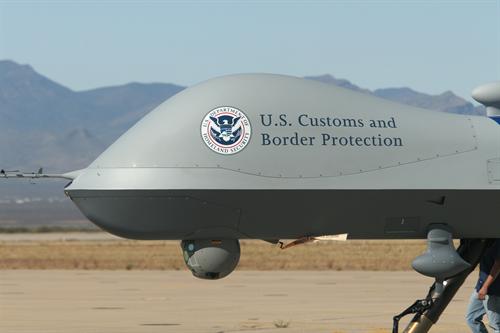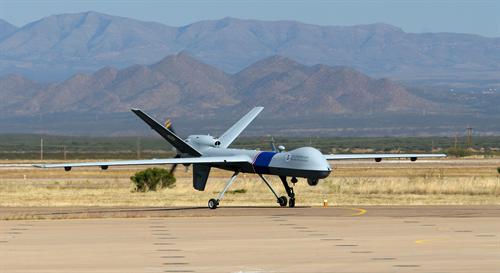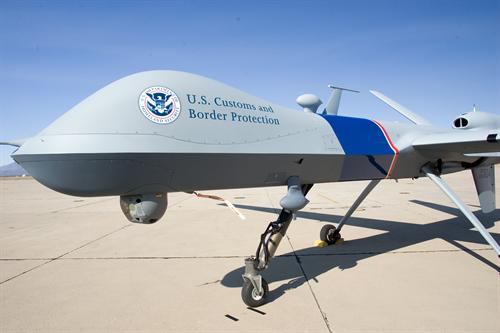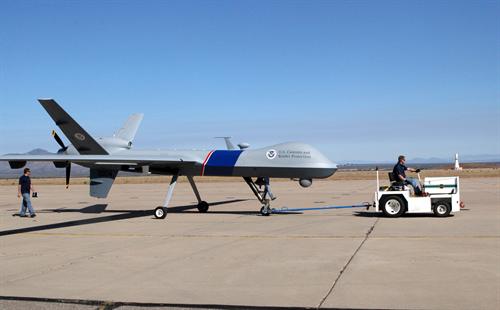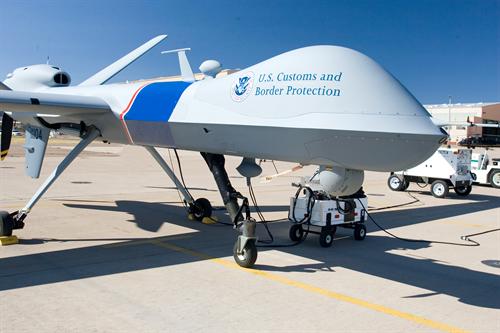UAVs to start patrolling Texas-Mexico Border
Washington, Aug 30 - Today, Congressman Henry Cuellar (TX-28) announced that starting Wednesday, Customs and Border Protection (CBP) will begin operating an Unmanned Aircraft System (UAS) along the Texas-Mexico border in an effort to help deter illegal activity.
This UAS will be housed out of the Naval Air Station in Corpus Christi, TX, which Congressman Cuellar visited last week.
“Today marks a critical next step in securing the Texas-Mexico border. By positioning this aircraft in Texas, CBP can further combat illegal activity along our southern border,” said Congressman Cuellar, Chairman of the U.S. House Homeland Security Subcommittee on Border, Maritime and Global Counterterrorism.
For six months, Congressman Cuellar, along with several other Texas lawmakers from both parties, has worked in coordination with CBP and FAA to bring the UAV program to Texas.
The UAS will fly over the Texas-Mexico border between El Paso and Brownsville along the Rio Grande. In addition, CBP will patrol the state’s coastline along the Gulf of Mexico. The remotely-piloted aircraft, known as a Predator B, can fly for up to 20 hours and provide BP with real-time critical intelligence information from attached cameras, sensors and radar systems.
According to CBP, since 2005, Predator Bs have flown more than 1,500 hours in support of border security missions and have assisted in the apprehension of more than 4,000 illegal aliens, in addition to the seizure of more than 15,000 pounds of marijuana.
“These aircrafts are a force multiplier for our border law enforcement,” said Congressman Cuellar. “They have the endurance and flexibility required to patrol our border and they collect critical information that will protect our communities.”
There will be a formal announcement at the UAS hanger in Corpus Christi on Sept. 8, 2010. Commissioner of U.S. Customs and Border Protection Alan D. Bersin and Congressman Cuellar, among others, will be in attendance.
For more information on the CBP UAV program, please visit:
http://www.cbp.gov/xp/cgov/border_security/air_marine/uas_program/uasoverview.xml
Pharr International Bridge Begins Operating SENTRI Lane
Pharr, Texas, Aug 30 – U.S. Customs and Border Protection (CBP) in conjunction with the City of Pharr will begin operating a SENTRI lane at the Pharr International Bridge. SENTRI, which stands for Secure Electronic Network for Travelers Rapid Inspection, is a trusted traveler land border-crossing program that provides expedited CBP processing for pre-approved low-risk travelers.
On Thursday, Sept. 3rd, 2010, CBP will begin operating a new modified vehicular SENTRI lane at the Pharr, Texas International Bridge. Another such lane already operates at the Anzalduas International Bridge. A true dedicated SENTRI lane has been in operation at the Hidalgo crossing for several years. In addition to the vehicular lanes, Hidalgo also operates a SENTRI pedestrian lane.
Starting Thursday, the hours of operation for the new Pharr SENTRI lane are as follows:
• 3 pm to 8 pm –Monday thru Friday and closed on weekends
Starting on Aug. 23, the hours of operation change to the following:
• 6 am to 8 am and 3 pm to 8pm – Monday thru Friday and closed on weekends
Prospective SENTRI participants may now apply online at www.cbp.gov as well as pay application and other program fees online.
The SENTRI program was first implemented at Otay Mesa, CA in 1995, and has grown to include 16 lanes at the largest ports of entry along the U.S.-Mexico border including San Ysidro, CA; Calexico, CA; Nogales, AZ; two crossings in El Paso, TX; Laredo, TX; Hidalgo, TX; and Brownsville, TX. More than 175,000 travelers from both sides of the border currently are enrolled in the program.
TRAVEL ALERT FOR MEXICO:
Millions of U.S. citizens safely visit Mexico each year. This includes tens of thousands who cross the border every day for study, tourism or business and at least one million U.S. citizens who live in Mexico. The Mexican government makes a considerable effort to protect U.S. citizens and other visitors to major tourist destinations. Resort areas and tourist destinations in Mexico do not see the levels of drug-related violence and crime reported in the border region and in areas along major drug trafficking routes. Nevertheless, crime and violence are serious problems. While most victims of violence are Mexican citizens associated with criminal activity, the security situation poses serious risks for U.S. citizens as well.
It is imperative that U.S. citizens understand the risks involved in travel to Mexico, how best to avoid dangerous situations, and who to contact if one becomes a victim of crime or violence. Common-sense precautions such as visiting only legitimate business and tourist areas during daylight hours, and avoiding areas where criminal activity might occur, can help ensure that travel to Mexico is safe and enjoyable. U.S. citizen victims of crime in Mexico are urged to contact the consular section of the nearest U.S. Consulate or Embassy for advice and assistance.
General Provisions:
Since 2006, the Mexican government has engaged in an extensive effort to combat drug-trafficking organizations (DTOs). Mexican DTOs, meanwhile, have been engaged in a vicious struggle with each other for control of trafficking routes. In order to prevent and combat violence, the government of Mexico has deployed military troops and federal police throughout the country. U.S. citizens should expect to encounter military and other law enforcement checkpoints when traveling in Mexico and are urged to cooperate fully.
DTOs have erected unauthorized checkpoints, and killed motorists who have not stopped at them. In confrontations with the Mexican army and police, DTOs have employed automatic weapons and grenades. In some cases, assailants have worn full or partial police or military uniforms and have used vehicles that resemble police vehicles. According to published reports, 22,700 people have been killed in narcotics-related violence since 2006. The great majority of those killed have been members of DTOs. However, innocent bystanders have been killed in shootouts between DTOs and Mexican law enforcement or between rival DTOs.
Recent violent attacks and persistent security concerns have prompted the U.S. Embassy to urge U.S. citizens to defer unnecessary travel to Michoacan and Tamaulipas, to parts of Chihuahua, Sinaloa, Durango, and Coahuila, and to advise U.S. citizens residing or traveling in those areas to exercise extreme caution.
Violence Along the U.S.-Mexico Border
Much of the country's narcotics-related violence has occurred in the northern border region. For example, since 2006, three times as many people have been murdered in Ciudad Juarez, in the state of Chihuahua, across from El Paso, Texas, than in any other city in Mexico. More than half of all Americans killed in Mexico in FY 2009 whose deaths were reported to the U.S. Embassy were killed in the border cities of Ciudad Juarez and Tijuana.
Since 2006, large firefights have taken place in towns and cities in many parts of Mexico, often in broad daylight on streets and other public venues. Such firefights have occurred mostly in northern Mexico, including Ciudad Juarez, Tijuana, Chihuahua City, Nogales, Nuevo Laredo, Piedras Negras, Reynosa, Matamoros and Monterrey. Firefights have also occurred in Nayarit, Jalisco and Colima. During some of these incidents, U.S. citizens have been trapped and temporarily prevented from leaving the area.
The situation in northern Mexico remains fluid; the location and timing of future armed engagements cannot be predicted. U.S. citizens are urged to exercise extreme caution when traveling throughout the region, particularly in those areas specifically mentioned in this Travel Warning.
The level of violence in Monterrey is increasing and has spread to areas near a school where many U.S. citizen children attend. Local police and private patrols do not have the capacity to deter criminal elements from areas around schools. Given the increasing level of violence that is occurring all over Monterrey, school children are at a significantly increased risk. Based on this, and combined with the high incidence of kidnappings in the Monterrey area, U.S. government personnel from the Consulate General have been advised that the immediate, practical and reliable way to reduce the security risks for their children is to remove them from the city. Beginning September 10, 2010, the Consulate General in Monterrey will become a partially unaccompanied post with no minor dependents of U.S. government employees.
In recent months, DTOs have used stolen trucks to block major highways and thus prevent the military from responding to criminal activity, most notably in the area around Monterrey. Also in Monterrey, DTOs have kidnapped guests out of reputable hotels in the downtown area, blocking off adjoining streets to prevent law enforcement response. DTOs have also attacked Mexican government facilities such as military barracks and a customs and immigration post.
The situation in the state of Chihuahua, specifically Ciudad Juarez, is of special concern. Mexican authorities report that more than 2,600 people were killed in Ciudad Juarez in 2009. Three persons associated with the Consulate General were murdered in March, 2010. U.S. citizens should defer unnecessary travel to Ciudad Juarez and to the Guadalupe Bravo area southeast of Ciudad Juarez.. From the United States, these areas are often reached through the Fabens and Fort Hancock, TX ports-of-entry. In both areas, American citizens have been victims of drug related violence. There have been recent incidents of serious narcotics- related violence in the vicinity of the Copper Canyon in Chihuahua.
Travelers on the highways between Monterrey and the United States (notably through Nuevo Laredo and Matamoros) have been targeted for robbery that has resulted in violence and have also been caught in incidents of gunfire between criminals and Mexican law enforcement. Travelers should defer unnecessary travel on Mexican Highway 2 between Reynosa and Nuevo Laredo due to the ongoing violent competition between DTOs in that area. Criminals have followed and harassed U.S. citizens traveling in their vehicles in border areas including Nuevo Laredo, Matamoros, and Tijuana. U.S. citizens traveling by road to and from the U.S. border through Nuevo Leon, Coahuila, Durango, and Sinaloa should be especially vigilant. Criminals appear to especially target SUVs and full-size pick-up trucks for theft and car-jacking along these routes.
Continued concerns regarding road safety along the Mexican border have prompted the U.S. Mission in Mexico to impose certain restrictions on U.S. government employees transiting the area. Effective July 15, 2010, Mission employees and their families may not travel by vehicle across the U.S.-Mexico border to or from any post in the interior of Mexico. This policy also applies to employees and their families transiting Mexico to and from Central American posts. This policy does not apply to employees and their family members assigned to border posts (Tijuana, Nogales, Ciudad Juarez, Nuevo Laredo, and Matamoros), although they may not drive to interior posts as outlined above. Travel is permitted between Hermosillo and Nogales, but not permitted from Hermosillo to any other interior posts.
U.S. citizen visitors are encouraged to stay in the well-known tourist areas. Travelers should leave their itinerary with a friend or family member not traveling with them, avoid traveling alone, and check with their cellular provider prior to departure to confirm that their cell phone is capable of roaming on GSM or 3G international networks. Cell phone coverage in isolated parts of Mexico, for example, the Copper Canyon, is spotty or non-existent.
Do not display expensive-looking jewelry, large amounts of money, or other valuable items. Travelers to remote or isolated venues should be aware that they may be distant from appropriate medical, law enforcement, and consular services in an emergency situation.


